Manual Data Entry or OCR? Choose the Smarter Fit for Salesforce
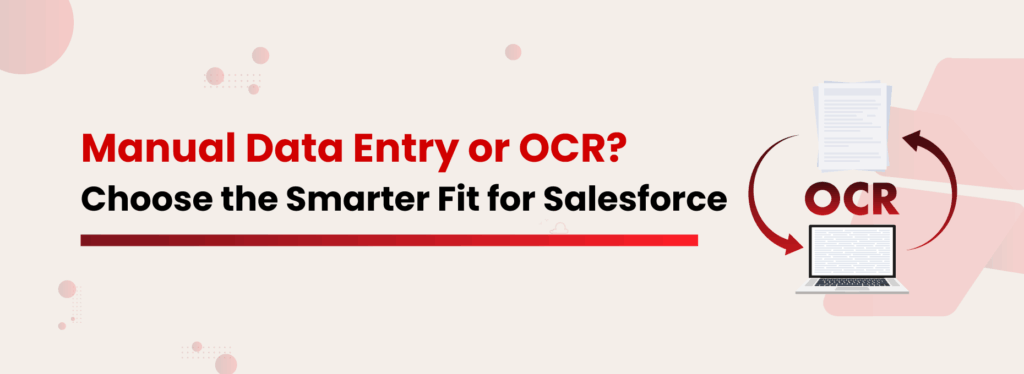
Data is the lifeblood of your business workflow. From customer onboarding forms to service request documents and compliance reports, our business is drowning in data-heavy processes that demand accuracy and speed. When we refer to data-heavy operations, it also means the manual process of transforming handwritten or paper-based document information into digital content. This practice has been the norm for decades, as manual data processing is often seen as a guarantee of trustworthiness. But today, OCR data extraction or Optical Character Recognition is changing the game. With automated data extraction becoming more accessible and accurate, Salesforce users started adopting OCR expertise to streamline their daily work. However, many are still uncertain about OCR, as manual data entry is still widely trusted and executed. Let’s discuss it in this article! Understanding Manual Data Entry vs OCR Data Extraction We all know about manual data entry. It’s the traditional process of inputting information about customers, invoices, or form submissions into the system. OCR (Optical Character Recognition) data extraction, on the other hand, automates this process by scanning documents, including PDFs, images, and printed forms, and converting them into structured Salesforce records. This advanced technology identifies printed or handwritten text within these files and transforms it into machine-readable formats. How are both manual data entry and OCR data extraction different in Salesforce? Here’s a closer look at how both approaches compare across the business-critical factors. Speed and Efficiency Manual Data Entry in Salesforce: It’s a slow, resource-heavy process that demands extensive human effort. Handling large volumes of documents manually can consume hours of work and tie up your team in repetitive tasks. OCR for Salesforce: Exceptionally fast and efficient. Salesforce data entry automation can handle hundreds or even thousands of documents in a fraction of the time, allowing your team to focus on more strategic operations. Accuracy Manual Data Entry in Salesforce: Manual data entry is prone to human error, misspelled names, overlooked fields, or incorrect values that can easily slip in, affecting overall data reliability and decision-making. OCR for Salesforce: An advanced, AI-driven OCR solution can offer high levels of accuracy, especially with printed documents. While occasional errors may occur, intelligent algorithms can detect ambiguities, learn from corrections, and continuously refine performance over time. Cost Efficiency Manual Data Entry in Salesforce: Here, the ongoing costs such as hiring, training, managing errors, and maintaining teams add up and make it an expensive process over time. OCR for Salesforce: Although it may require an upfront investment, it pays off quickly with lower operational costs and increased processing efficiency. Scalability Manual Data Entry in Salesforce: Scaling is a challenge in manual data processing. As document volume grows, so does the need for additional manpower, training, and oversight, making it costly and inefficient. OCR for Salesforce: Salesforce data entry automation is designed to scale effortlessly. Whether you’re handling a few hundred or hundreds of thousands of documents, OCR-powered functionality for Salesforce adapts seamlessly without increasing operational overhead. Security & Compliance Manual Data Entry in Salesforce: Manual data processing can lead to human errors, data loss, and security breaches, especially when relying on physical records or unsecured systems. OCR for Salesforce: OCR technology enhances data security with encryption, access controls, and detailed audit logs. It also simplifies compliance with industry regulations and data privacy laws. Document Management Workflow Manual Data Entry in Salesforce: Here, you often need to operate in silos with minimal system integration that could cause delays and workflow disruptions due to human dependencies. OCR for Salesforce: You can easily connect with document management systems and automation tools, enabling smoother workflows, real-time updates, and greater process transparency. So, overall, what do you think? Does your Salesforce workflow demand manual data entry or OCR data extraction? Undoubtedly, OCR technology is the winner! How Does OCR Technology Help in Daily Life? Let’s look into some use cases of OCR data extraction for different industries. Healthcare: OCR can extract data from patient intake forms, prescriptions, and lab reports, then automatically reflect them in the respective records. This streamlines patient onboarding and ensures accurate, centralized health records.Finance & Banking: Banks and financial institutions use OCR to capture data from KYC documents, bank statements, and loan applications. The extracted data flows into your Salesforce workflow, accelerating customer onboarding and ensuring regulatory compliance. Legal: Law firms scan contracts, legal briefs, and case documents using OCR, which extracts critical information like client names, dates, and clauses. This data is then mapped to Salesforce case records, enabling quick access and efficient case tracking.Logistics: OCR reads shipping labels, delivery notes, and bills of lading to automatically feed the data into Salesforce. This ensures real-time shipment tracking, fewer errors, and smoother coordination across supply chain operations.Retail & eCommerce: Retailers use OCR to extract details from order forms, invoices, and receipts, syncing the data with Salesforce for inventory and vendor management. This helps streamline order processing, reduce errors, and maintain accurate stock and financial records. OCR: The Winner It’s clear now! OCR technology wins over manual data entry for your Salesforce workflow, given the speed, accuracy, scalability, and cost-efficiency of OCR. As more Salesforce users seek to streamline operations and improve bottom lines, the adoption of OCR is critical for your document management operations. At XfilesPro, we make it easier for you to adopt OCR for your Salesforce document management workflow. For this, we offer advanced, AI-powered data extraction capability that converts documents into editable and searchable data and maps with your corresponding Salesforce record. If you wish to learn more about XfilesPro’s AI-enhanced OCR functionality for Salesforce, please hit us up! Deeshna CDeeshna is a five-year experienced writer in the field of B2B, writing a wide range of content types that drive the success of SaaS products. All Posts www.xfilespro.com
Automating Loan Documents in Salesforce with OCR & Salesforce Document Generation
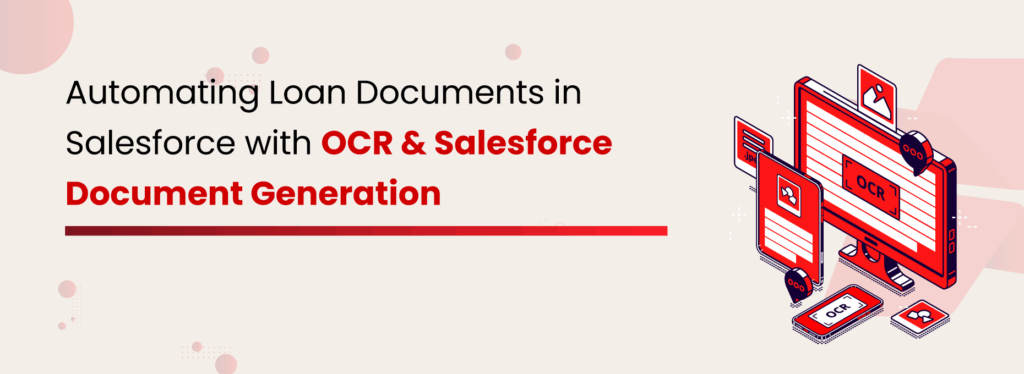
In today’s booming world, everything seems to come with a price tag. For this reason, many individuals turn to loans to fund their dreams, be it buying a home, expanding a business, or covering major expenses. For financial institutions using Salesforce, processing loans, especially at scale, requires handling large volumes of policy data, compliance documentation, and complex verification workflows. That’s where document automation tools come in, like an insurance policy for your Salesforce. They protect your workflow from delays, reduce manual effort, and streamline everything from loan data handling to compliance docs. Why Insurers Use Salesforce for Loan Process Management Most insurance companies are moving away from legacy administration systems and adopting Salesforce to manage customer data more efficiently. With its customizable platform and suite of Clouds, Salesforce can be tailored to handle every aspect of policy administration, from quote management and underwriting to policy servicing. It offers a single source of truth for all customer and loan information, eliminating the need for scattered systems and improving operational efficiency. The Manual Process Behind Loan Processing Traditional methods of managing a loan rely heavily on paperwork, siloed systems, and manual coordination between teams. From verification to loan approval and servicing, the lack of automation often results in inefficiencies, longer turnaround times, and poor customer experiences. It’s a process ripe for digital transformation. Before diving into automation, it’s important to understand the current steps involved in managing a loan process—and why they need a digital upgrade. Loan Eligibility Check Before starting the loan process, the agent verifies if the applicant is eligible. This involves retrieving the borrower’s/applicant’s profile in Salesforce and reviewing the KYC details, like income, credit score, government-issued IDs (SSN), or existing liabilities. Since this data isn’t always integrated, agents jump between Salesforce, spreadsheets, or admin portals to confirm eligibility. Eligibility Calculation The potential loan amount is calculated based on predefined criteria like income-to-loan ratio or creditworthiness. Agents manually enter data into custom Salesforce fields and use offline tools (like Excel) to run calculations. There are no built-in validations or rule-based suggestions in Salesforce, leading to inefficiencies and manual errors. Document Collection Applicants must submit documents like ID proof, address proof, income statements, and bank statements. Agents email or call applicants with the checklist. Documents arrive in inconsistent formats—photos, PDFs, scans—which agents must manually download, rename, convert, and compile. The result is a time-consuming, unstructured workflow. Loan Application Preparation Once documents are gathered, agents fill out loan application forms manually or via editable PDFs. Supporting files are individually attached or printed and compiled into a single application package. If any information is missing, the agent has to start over—adding more delays. Approval Workflow The loan file is routed to internal teams like credit, risk, and compliance for review. This handoff typically happens through emails or uploads to shared folders. Each reviewer may send manual feedback or request updates, and there’s no real-time system to track loan status. Agents rely heavily on follow-ups. Financial File Management, Redefined: Efficiency, Security & Collaboration in One Solution Download the Case Study! Compliance Check Each application must adhere to regulatory and internal compliance requirements. Agents refer to offline checklists to verify fields and documents, manually flagging issues like expired IDs or missing signatures. A single error can delay the entire process. Disbursement Once approved, the loan must be disbursed. Agents coordinate with finance teams via emails or phone calls, submitting disbursement instructions along with documents. It may take days to confirm transfer, and the agent must inform the applicant manually when the funds are released. Record Maintenance All loan details, documents, and notes must be logged into Salesforce or internal systems. This is usually double data entry—once in a form, then again in the CRM. Agents must also upload documents, tag them properly, and ensure the loan record is accessible for audits and customer service in the future. The entire manual process involves extensive data entry, downloading and re-uploading documents, cross-verifying information, and constantly switching between systems. That’s why automating these tasks is crucial, but how can you do that within Salesforce? The answer: XfilesPro DocGen and Document Management in Salesforce for Insurance Loan Automation Powerful & Efficient Automated Salesforce Document Generation Get the Datasheet! XfilesPro DocGen: Loan Automation in Salesforce XfilesPro is a trusted Salesforce document generation and management solution designed to make life easier for Salesforce users. With over 15 years of industry experience, we’ve helped more than 1,000 customers streamline their document processes. What’s our secret? A powerful combination of reliability, flexibility, and seamless integration that consistently delivers results. A Leading Swiss Insurance Provider Transformed Their Insurance Process with XfilesPro Get the Full Case Study XfilesPro offers three powerful solutions An OCR-powered tool (Xtract) A document generation application (DocGen) A platform for storage and collaboration Let’s see how these can help simplify Salesforce loan processing. Extract Document Details Within Salesforce Xtract is an AI-powered OCR solution that scans forms, handwritten notes, and images into structured Salesforce data, making it perfect for managing loan requests tied to insurance policies. Turn Scanned Documents Into Smart, Searchable Data Inside Salesforce Download the Datasheet! For instance, during the loan application process, an agent can simply upload a scanned copy of the customer’s insurance policy using Xtract. The OCR-powered tool reads the document, pulls out key data like policy number and surrender value, and maps it directly to the relevant Salesforce fields. This eliminates the need for switching between platforms, minimizes errors, reduces manual entry, and speeds up the entire process. Automate Document Generation and Approval Workflow With XfilesPro DocGen, you can automate every step of the Loan process directly within Salesforce, reducing delays, eliminating manual errors, and ensuring full compliance. Template Management Build and reuse templates for key documents like loan applications, policy eligibility reports, consent forms, and disbursement letters to maintain consistency and accuracy across all records. Dynamic Data Mapping Automatically populate documents with real-time Salesforce data, like customer details, surrender value, loan amount, and tenure, eliminating manual entry and reducing errors. Review &
Optimize Your Salesforce Purchase Order Process in Four Steps
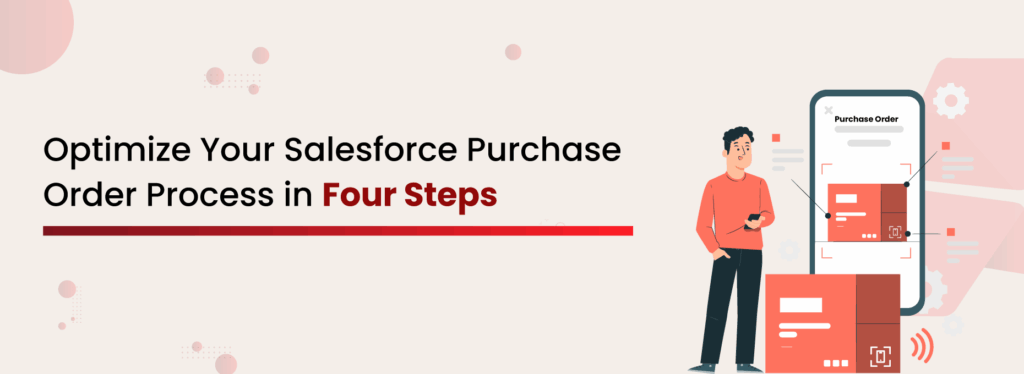
The Purchase Order (PO) process is essential for every business, whether it’s a simple stationery purchase or a large-scale heavy equipment requirement. No matter the size of the procurement need, the process ensures accountability, transparency, and traceability. However, many companies still rely on disjointed systems: Salesforce for customer data, third-party apps for document generation, and external cloud storage for files. This fragmented approach forces procurement teams to manage and track POs across platforms manually. And this isn’t just an inconvenience, it’s a risk. Manual processes open the door to errors, lost documents, delayed approvals, compliance issues, and even payment disputes. One missed document or outdated version could mean stalled deliveries, strained vendor relationships, or financial discrepancies. In short, a broken PO process can break your entire business flow. Now, what if we told you XfilesPro can change that? We can automate your PO process. Trust us when we say that it isn’t just any other tool. But before we show you how we’re different, let’s quickly walk through something every business deals with: Understanding the Purchase Order Lifecycle in Salesforce To truly optimize purchase order management, you need to understand its full lifecycle. Here’s how a typical PO flows through Salesforce: A Purchase Request (PR) is raised to initiate the procurement of goods or services. The PR goes through an internal approval workflow involving department heads. Quotations are collected from multiple vendors for comparison and selection. A Purchase Order (PO) is generated based on the approved PR and the chosen vendor. The PO is sent to the selected vendor, who then confirms and ships the requested items. Goods are received and inspected, and the delivery is matched against the original PO. An invoice is received from the vendor and processed for payment. All associated documents are stored securely for future reference, compliance, and audits. While the process may seem straightforward, many organizations struggle to manage it efficiently due to disconnected systems, manual workflows, and limited visibility. Why Manual Handling of the Salesforce Purchase Order Process is a Hassle At a glance, the PO process might look structured, but behind the curtain, it’s often far from it. Without a unified system, each stage becomes its own mini-project. Requests are logged in Salesforce, but approvals bounce around in email threads, causing delays. The PO is generated in another system and emailed manually, with no link back to the record. Goods arrive, but the team struggles to match deliveries with the right PO because versions are stored across multiple folders. The finance team loses time locating the right invoice or verifying approval history. During audits, the documentation trail is incomplete or inconsistent. Salesforce and the XfilesPro DocGen tool are a dream team; together, they fix the broken PO process by turning scattered tasks into a seamless, automated workflow. How can XfilesPro DocGen help with the Salesforce Purchase Order Process? Our Document Generation isn’t just another tool. It goes beyond the basic “click and generate” functionality. XfilesPro DocGen is built to simplify, streamline, and strengthen your Salesforce document generation process. Here is how the tool helps in automating the Salesforce purchase order. Powerful & Efficient Automated Salesforce Document Generation Get the Datasheet! Template Setup Made Simple We offer a wide range of pre-built templates, tailored by industry and department. When it comes to the Purchase Order process, you can easily raise a Purchase Request document using one of our ready-to-use templates. No need to design anything from the ground up. Just select the template that fits your needs, make a few quick edits, and you’re good to go. Automated Data Population XfilesPro pulls real-time data from Salesforce records, so your Purchase Requests and POs are always accurate and up to date. Just select the materials or services you need, and the relevant details populate instantly, saving time and reducing errors. Integrated Review, Approval & E-sign Workflow Once your document is drafted, even if you’ve customized the design to match your brand or internal formatting, it’s ready for internal review, approval, and even in-built Salesforce Signature, all within Salesforce. Whether it’s a department head or the finance team, everyone involved can review, comment, approve, and sign the document in a single, unified flow. No external emails. No confusion. Just a clean, collaborative process with total visibility. Link Documents to the Right Salesforce Record After your document is approved, XfilesPro ensures it’s stored exactly where it should be. Delivery receipts, invoices, vendor confirmations, everything is automatically saved and linked to the correct Salesforce record. No manual uploads. No lost files. Just organized, audit-ready documentation. Get DocGen from AppExchange! Okay, cool—now your documents are saved to Salesforce records. But here’s the catch:They’re still eating up your Salesforce storage. They’re scattered. You’re still sending emails from Salesforce to multiple vendors for quotes or updates. And suddenly, you’re juggling email threads, switching tabs, and losing track of who said what. Yeah… not ideal. Salesforce Document Management, Upgraded With XfilesPro, all your documents, whether it’s a Purchase request, a PO, or a vendor quote, are stored in external cloud storage (like SharePoint, OneDrive, Google Drive, or AWS), not Salesforce. That means zero storage bloat, better organization, and real-time access from the record itself. How do we do it? Zero Storage Bloat With XfilesPro, you can set up automated triggers to move your files from Salesforce to your external cloud storage of choice. These triggers can be based on specific conditions, like when an Opportunity is marked as Closed Won, a Purchase Request (custom object) is approved, a Purchase Order (custom or managed package) is sent, or a Vendor Quote is finalized. Better Organisation You can set a specific folder path, like Procurement → Purchase Requests → 2025 → File A. Whenever a document is added to a record, such as a Purchase Request, it’s automatically saved in the right location. This folder structure, defined by Salesforce fields, is mirrored in your external storage as well. Automating Folder Structure and Document Organization for Financial Enterprise Using XfilesPro Download the Case
Speed Up Invoice Processing in Salesforce with XfilesPro OCR App
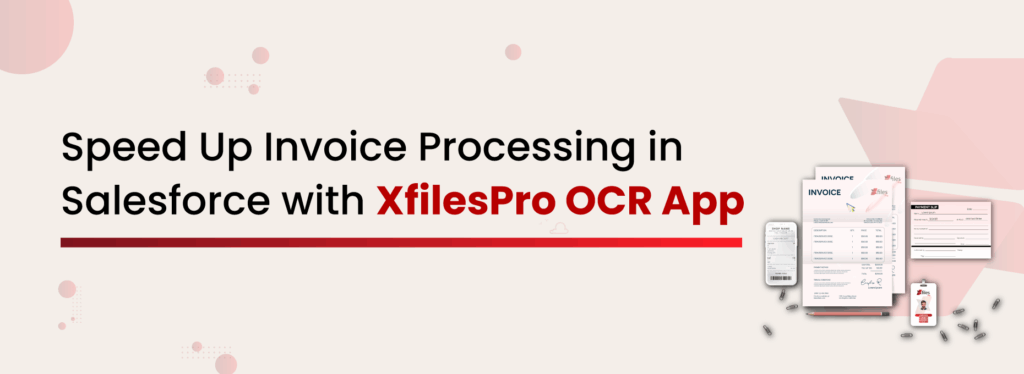
If you’re handling invoice processing in Salesforce, you probably know the drill—you need to scan through piles of documents, manually enter data into fields, and double-check for typos, all while risking errors. Invoice processing in Salesforce is a critical function for any business, but it’s a slow, repetitive task that involves hours of manual verification and management of financial data. Moreover, these delayed operations clog up your entire accounts payable workflow, which is inefficient and costly for a modern business. At XfilesPro, we value the effort and time of accounts payable departments in manually processing invoices. To help them save their day, we introduced an advanced AI powered application, Xtract, by leveraging the power of OCR technology. Before discussing more about Xtract, let’s take a glance at the challenges of manual invoice processing in Salesforce. Why Manual Invoice Processing is Holding You Back? Even if your business runs on Salesforce, relying on manual invoice processing can create more problems than solutions. It Consumes Too Much Time & Too Many Resources Manually entering data to create an invoice within Salesforce is tedious and time-intensive, especially when dealing with high volumes. Sales reps often spend hours typing in line items, cross-checking figures, and uploading supporting documents. This slows down the workflow and pulls focus from more strategic finance tasks. Manual Invoice Processing is Prone to Errors No matter how careful your sales reps are, manual entry increases the risk of typos, missed fields, and mismatched records. These errors can lead to incorrect payments, compliance issues, and frustrating back-and-forth with vendors. The more invoices you process, the higher the margin for error. It Lacks Real-Time Visibility and Automation Manual processes rarely give you a clear, up-to-the-minute view of invoice status or payment progress. Without automation, tracking approvals or identifying bottlenecks becomes a guessing game. This slows down decision-making and limits your ability to respond quickly. Now, let’s get back to OCR. The Role of OCR for Invoice Processing in Salesforce Optical Character Recognition is a modern technology that advances your mundane invoice processing. OCR converts documents – whether it’s scanned, printed, or handwritten, such as paper documents, PDF files, or images captured by a digital camera- into editable and searchable data. It automatically pulls out key details like invoice numbers, dates, vendor names, line items, and total amounts, and maps them into the corresponding fields of Salesforce. By transforming these data points from static images or PDFs into dynamic text, OCR significantly enhances the efficiency, speed, and accuracy of the accounts payable process. Xtract: The Advanced OCR App for Invoice Processing in Salesforce Now, let’s get back to Xtract, the advanced OCR app for Salesforce from the house of XfilesPro. Powered by AI, Xtract is built for Salesforce to simplify and accelerate your document-based data entry. We have designed Xtract with ease of use in mind so that it seamlessly integrates into your existing Salesforce environment without demanding external tools or complex setup procedures. Xtract supports a wide range of formats, including PDFs, scanned documents, and even handwritten invoices or notes. If you’re dealing with any document-heavy workflow, including invoice processing, Xtract’s OCR engine reads, captures, and maps key data fields directly into Salesforce objects, which makes your invoicing process faster, smarter, and far more efficient. How Does Xtract Speed Up Invoice Processing in Salesforce? Multiple factors can accelerate your accounts payable automation in Salesforce. Auto-Capture Key Invoice Fields As said already, the Xtract OCR intelligently scans invoices and instantly identifies essential data points like invoice numbers, vendor names, due dates, and total amounts. It eliminates the need for users to manually comb through each document; instead, they can capture critical fields and make them ready for immediate processing with minimal effort. Intelligent Data Mapping to Salesforce Objects Once extracted, Xtract enables the automatic mapping of data to the correct Salesforce records, such as Accounts, Opportunities, or custom objects. This ensures information flows directly into your system without disruption or duplication. The mapping logic is flexible and allows for both standard and custom workflows to be supported with ease. Eliminate Manual Entry Through Real-time Text Extraction The potential of Xtract OCR is enormous, so that it works in real-time, converting scanned or image-based invoice data into usable text the moment it’s uploaded. This eliminates hours of typing and checking, in turn, reducing both effort and error rates. As a result, your team can process more invoices in less time, with far greater accuracy. Automate Approval Workflows Using Extracted Data With invoice data already structured inside Salesforce, approval workflows can be triggered automatically based on predefined conditions, like due dates or amount thresholds. This means less chasing and fewer bottlenecks in the approval process. And, your finance team can move faster, stay organized, and ensure timely payments without extra coordination. Let’s make it clearer with a real-life example. Imagine a mid-sized finance team at a manufacturing company that handles over 300 vendor invoices every week. Without Xtract, the team needs to spend hours manually entering invoice details into Salesforce—matching vendor names, inputting invoice numbers, checking due dates, and double-verifying amounts. This process would be time-consuming, and high chance that it will cause errors that will lead to delayed approvals and occasional payment misses. With Xtract, key fields like invoice amount, vendor name, and due date were auto-captured and mapped into Salesforce records in real-time. With automation kicking off approval workflows instantly, the finance team saved nearly 80% of the time they previously spent on manual tasks. And, the results? The payment cycles became faster, data accuracy improved significantly, and the team could focus more on strategic financial oversight rather than administrative work. Key Benefits of Xtract for Invoice Processing Automation in Salesforce Automating invoice processing in Salesforce unlocks a wide range of powerful benefits for your finance team. 80–90% Reduction in Manual Data Entry Xtract cuts down the time and effort spent on entering invoice data by hand. With intelligent automation, most data fields are captured and populated instantly, which reduces human intervention
Why Businesses Need an OCR Solution in Salesforce?
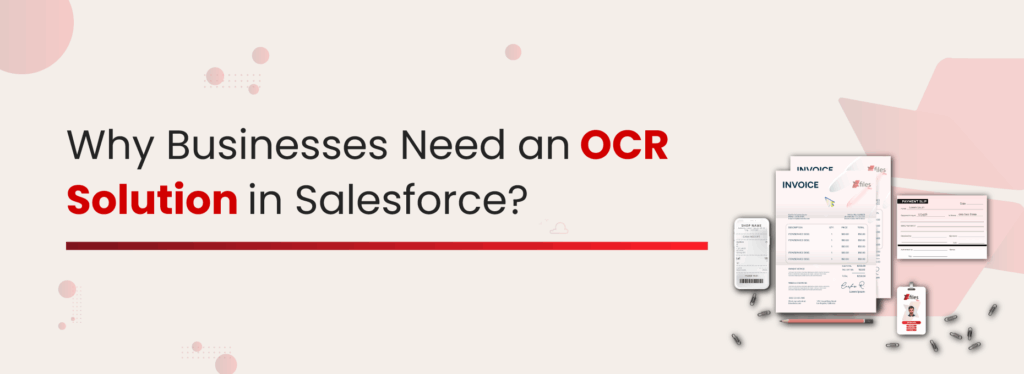
Ever received a PDF or image where you couldn’t copy a single word? Your first instinct might be to convert it into another file format just to extract the details. But when you’re dealing with document-heavy processes inside Salesforce, does this workaround scale? Absolutely not. That’s where Optical Character Recognition (OCR) steps in. This intelligent technology extracts text from scanned images and PDFs, turning printed or handwritten content into machine-readable data. And when embedded within Salesforce, the results can be game-changing. Why is OCR Critical for Salesforce? In ecosystems like Salesforce, where data drives every decision, OCR plays a pivotal role. Businesses frequently handle contracts, invoices, agreements, work orders, customer onboarding forms, and compliance documents – often in non-digital formats. Without automation, manual data entry poses challenges. It’s not only time-consuming, but also prone to human error, which can lead to inaccuracies and work discontinuity. Also, as the document volumes grow, your teams often struggle to scale their efforts efficiently, resulting in backlogs and delays. Beyond operational headaches, there’s also a risk to data security and compliance where even a small mistake can result in regulatory breaches or mishandled sensitive information. Altogether, these challenges spill over into the customer experience! How Does OCR Enhance Salesforce Workflows? Integrating Optical Character Recognition (OCR) with Salesforce can transform how your team handles data. By automating tedious, error-prone tasks, OCR streamlines operations and boosts the accuracy and speed of the data obtaining process. Here’s how OCR technology enhances your Salesforce workflows; Automated Data Extraction OCR technology can intelligently scan and extract data from a variety of sources, including scanned documents, PDFs, and image files. This eliminates the need for manual input, converting unstructured or hard-to-access data into organized, Salesforce-ready formats with minimal effort. Improved Accuracy Powered by Artificial Intelligence (AI), modern OCR tools significantly reduce human errors in data entry. By accurately recognizing characters and validating data formats, OCR ensures the information entering your Salesforce environment is reliable and consistent. Seamless Integration OCR solutions can be configured to integrate directly with Salesforce, which allows extracted data to populate standard and custom objects automatically. This not only streamlines workflows but also ensures that your Salesforce instance stays up-to-date in real time without manual syncing. Faster Processing & Decision-Making OCR dramatically accelerates the speed at which documents are processed—what once took hours can now be done in minutes. By making critical data available faster, your teams can make quicker, data-driven decisions and respond more promptly to customer needs. Key Benefits of Using an OCR Solution in Salesforce Implementing an OCR solution within Salesforce brings a range of valuable benefits. It boosts productivity by freeing employees from time-consuming manual data entry, instead allowing them to focus on higher-value tasks. This advanced technology also helps ensure compliance and data security by reducing human error and supporting proper handling of sensitive information in line with regulations like GDPR and HIPAA. Plus, you can benefit from cost savings, as automation reduces the need for additional resources and cuts operational expenses. Most importantly, through OCR technology, you can enhance the customer experience by speeding up document processing, enabling quicker responses, and more efficient service delivery. Let’s look into some instances where OCR for Salesforce comes in handy. Invoice Processing OCR can automatically extract key information from invoices, such as invoice number, date, line items, and total amount, and populate it directly into Salesforce. This reduces manual entry, speeds up the approval process, and ensures accurate financial records. Contract Management By digitizing physical or scanned contracts, OCR enables you to easily store, search, and manage legal agreements within Salesforce. It streamlines contract lifecycle management and ensures important clauses or dates are never missed. KYC & Identity Verification OCR can extract relevant data from documents like passports, driver’s licenses, or utility bills to accelerate Know Your Customer (KYC) processes. This improves onboarding efficiency and helps maintain compliance with regulatory requirements. Healthcare Records Management In healthcare environments, OCR can convert handwritten or scanned medical documents into structured, searchable records within Salesforce. This allows for faster access to patient information and better coordination across care teams. Claims Processing in Insurance OCR can streamline insurance workflows by extracting data from claim forms, supporting documents, and images submitted by customers. This automation accelerates the claims review process, reduces errors, and improves turnaround time for customer payouts. How to Choose the Right OCR Solution for Salesforce? It’s no longer automation that redefines the game — it’s Artificial Intelligence (AI). When selecting a modern OCR solution for Salesforce, you need to look for AI-powered recognition capabilities that ensure high accuracy, even with low-quality scans or complex layouts. The right tool should also support a wide range of file formats—from PDFs and scanned images to handwritten documents—so you’re not limited by input type. Similarly, seamless integration with Salesforce is key for automating workflows and ensuring data flows directly into the right objects without manual intervention. Keep in mind, you shouldn’t overlook security and compliance features; robust encryption, access control, and adherence to standards like GDPR or HIPAA are essential when handling sensitive information. Begin Your OCR Journey for Salesforce OCR technology is transforming the way businesses manage documents within Salesforce by turning time-consuming manual tasks into streamlined, automated processes. Given the huge potential of this modern method, why can’t your business leverage its benefits? Now is the time to embrace the shift and work smarter to serve customers better. We urge you to explore Xtract, our OCR solution for Salesforce, to experience a streamlined data extraction method. Hit us up today! Deeshna CDeeshna is a five-year experienced writer in the field of B2B, writing a wide range of content types that drive the success of SaaS products. All Posts www.xfilespro.com
What is Xtract? An Ultimate Guide to the AI-enhanced OCR App for Salesforce
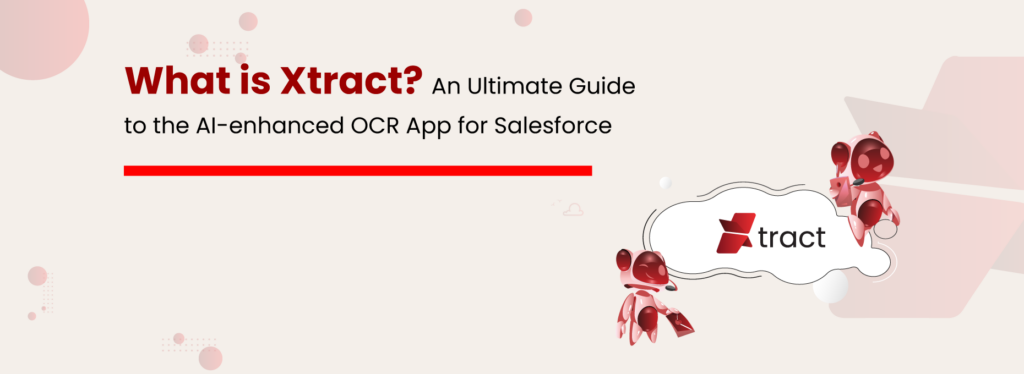
OCR is no longer a foreign concept for us. We witness a lot of businesses leveraging Optical Character Recognition (OCR) programs as part of their daily operations — and now, Salesforce users also rave about its potential. If you’re still unsure how OCR can add value to your business, let us help you learn about it in detail. In simpler terms, OCR is a technology that recognizes text within an image. Businesses often use an OCR program to extract and repurpose data from scanned documents, camera images, and image-only PDFs. OCR software identifies individual characters, assembles them into words, and then forms complete sentences — that way, transforming static images into machine-readable text. With advancements in artificial intelligence (AI), OCR has evolved to the next level. It’s no longer a conventional OCR that simply extracts information from a Salesforce document; it is an advanced solution that offers greater work efficiency. Let’s discuss some key benefits of AI-powered optical character recognition technology in your Salesforce environment. Higher Accuracy Manual data entry is prone to errors, causing inefficiencies and reputational damage for your business. Having a modern OCR program eliminates the need for manual typing by automatically extracting text from files and attachments inside Salesforce. This makes your documents and image files easily searchable and processable and ensures high data consistency. Improved Scalability Whether your business is small or large, an AI-enhanced OCR technology can meet both demands. That means an optical character recognition software is designed to grow with the evolving needs of your company and can handle a small business’s document processing needs as effectively as those of a large enterprise. Faster Turnaround Time Due to cumbersome tasks that create expensive bottlenecks, traditional document processing workflow mostly gets delayed. This results in customer dissatisfaction and inefficient operations that ultimately take a toll on your brand reputation. An OCR system can accomplish accurate data extraction in a matter of seconds, which saves 98% of time and reduces process delays. The Ultimate Solution Now that you understand the advantages of AI-powered OCR technology, let us introduce you to Xtract, an AI-powered application for extracting details from your business documents. What is Xtract? Xtract is the newly launched AI-enhanced application from the house of XfilesPro. Leveraging OCR technology with the power of AI, the application extracts textual information from a Salesforce document and uses it for a relevant use case. Xtract’s AI engine is so robust that it scans every document and image associated with a record and automatically initiates extraction. Once the data is pulled, the application maps them precisely with respective Salesforce fields to keep the details up-to-date. The best part is that Xtract’s AI engine ensures the accurate and consistent entry of extracted details to the fields, meaning you can achieve peace of mind. Xtract’s OCR technology can be applied in a variety of business scenarios to enhance efficiency and accuracy. Here are some of those. Invoice Processing : Automating the extraction of data from invoices, receipts, and financial statements by speeding up the accounts payable process. Handwritten Notes Recognition : Efficiently digitizing doctors’ handwritten prescriptions and notes for easy access in the healthcare domain. Receipt Scanning : Extracts the purchase details of expense management and pulls the relevant details as a helping hand for workers in retail and e-commerce. Digitization of Books & Study Materials : Converting printed books, guides, and journals into digital formats for smooth learning and reference. Form Processing : Intelligently automates the data entry for tax forms, census records, and permit applications for the legal and government sector. Taking OCR to the Next Level with AI and Xtract If your business needs to improve the bottom line and enhance customer experience, Xtract can be a wise addition to your operations. If you wish to learn more about how best Xtract can work for your business, do Connect with us! Our team is happy to take this forward! Deeshna CDeeshna is a five-year experienced writer in the field of B2B, writing a wide range of content types that drive the success of SaaS products. All Posts www.xfilespro.com

